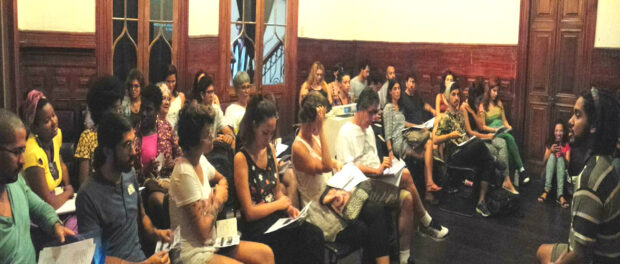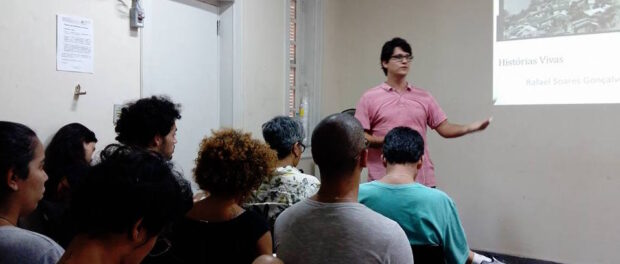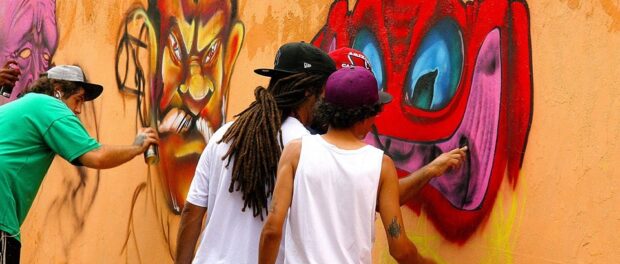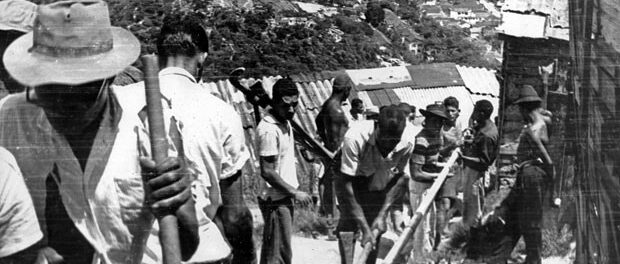
Forty-three students, favela residents, researchers and other interested people participated in the course “Living Stories – The history of resistance in Rio’s favelas,” organized by Gizele Martins and Anderson Caboi as part of the cultural and interdisciplinary exhibition “What Legacy.” Professors, community leaders and students of last year’s edition helped with the promotion of the course, which took place during three Saturdays at the Castelinho in the South Zone neighborhood of Flamengo.
Covering a variety of topics, such as the emergence of favelas, their development over time, sanitation, education, housing, public security, community media and favela culture, the course provided a platform for both favela residents as well as academics to tell the history of favela resistance from multiple perspectives.
The first Saturday, March 25, kicked off with a presentation by Pontifical Catholic University (PUC) professor and attorney Rafael Soares Gonçalves. By discussing the history of favela emergence and development, he aimed to describe and highlight the connection between past and current situations. Gonçalves deconstructed persisting common ideas, for example by showing that favelas have never really been marked by a complete absence of the state. Rather, the state has throughout history attempted to regulate favelas.
Yet, Rafael also highlighted the constant resistance and demands made by favela residents, which eventually led to a shift from an evictions-focused approach (until the 1980s) to a focus on upgrading, with the emergence of programs such as Proface (installing sanitation infrastructure), projects to increase electricity coverage in favelas, the largest upgrading program known as Favela-Bairro in the 1990s, the Growth Acceleration Program (PAC) and Morar Carioca.
However, evictions never disappeared in Rio: Sandra Maria from Vila Autódromo in the city’s West Zone showed how evictions are still a cruel reality for many favelas. Since 1992, the calm favela with approximately 700 families in 2013, fought numerous attempted evictions, under various pretexts, most notably the Olympics, but actually due to real estate interests in a favela-free landscape in the region. Sandra argued that “mega-events are the most powerful weapon that capitalism uses today” for evictions, adding that the argument of favelas being environmental hazards is a false one as “in many cases these areas are deforested and reoccupied” once the favela residents have been removed, imposing much greater damage to the environment. Her presentation particularly pointed out the violence that is used by police to counter peaceful resistance by residents, the use of psychological pressure as well as the strong internal organization of Vila Autódromo.
This first session of the course was wrapped up by a brainstorming activity, led by Providência resident, activist and favela tour guide Cosme Felippsen, on what “favela” means to each one of the participants. The activity highlighted the complexity and multiplicity that favelas represent today, with “resilience,” “favela as a solution,” “favela culture,” “resistance,” “struggle,” “unity,” and “home” being among the most mentioned characteristics.
The following class took place after a week of escalating violence and killings in Rio’s favelas. Gizele Martins, who spoke of the “big massacre” in her community of Maré, shared some remarks on the current alarming situation within favelas, where “more than 20 deaths [occurred] in only one week [and] 200 people were assassinated within three months in Rio de Janeiro.”
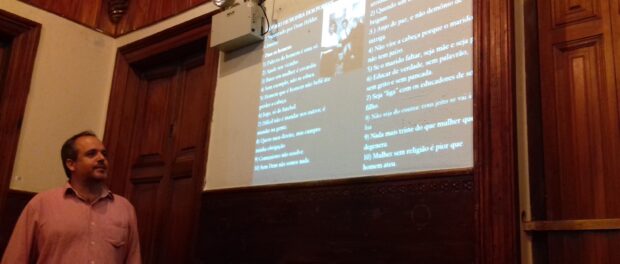
Mario Brum, professor at the State University of Rio de Janeiro (UERJ), then traced the development of eviction policies, highlighting the continuous stigmatization of favelas, and referring to the current wave of violence against residents. Similar to the Vila Autódromo case explained earlier by Sandra, Mario pointed out that environmental disasters and mega-events are often used as justifications for evictions.
Following this, Lu Brasil from the Coletivo Voz Urbana focused her class on the densely populated Baixada Fluminense region. Based on the 2010 census by the Brazilian Institute for Geography and Statistics (IBGE), she pointed out that 70% of favela residents in the region live in only three cities of the Baixada Fluminense, whose favelas host more than 200,000 people. Lu resides in one of the most populous favelas of the region, Vila Operária (approximately 9000 residents), which is considered a model of community urbanization due to its good access to water, electricity and waste collection, paved roads, a high number of schools, and free training and certification courses, among others. In 2006, this favela received further public attention due to the emergence and promotion of “Meeting of Favela” (MoF), a Vila Operária-based graffiti group that “aims to increase social and cultural visibility of the favela and transform it into an outdoor art gallery.”
The next presenter, Glaucia Marinho of the Brazilian NGO Global Justice, shifted the focus from Vila Operária to the center of Rio and the Porto Maravilha port revitalization program. Many of the numerous abandoned buildings in the city’s port region were “structures ready for housing,” and had been officially occupied by families starting in 2004. The official occupation of buildings in this area “brought up the African past” of the city, according to Glaucia. A short while later, the Porto Maravilha project, intended to revitalize the area, was designed and implemented, including the elimination of those occupations and evicting families living there. As critiqued by Glaucia, in many cases “there was no communication by any representative [with the residents and] everyone only learned about [the planned evictions] through the newspaper.”
During the last session, course participants explored the topic of public security in favelas through presentations by UERJ professor Mauro Amoroso, Fransérgio Goulart (Center of Human Rights of the Nova Iguaçu Diocese) and Maré resident Carlos Gonçalves. By recounting stories of the Military Police in favelas, Mauro brought to the class a discussion on the meaning of urban space, the impact of Military Police actions on the city, and processes of urban segregation, where favelas are constantly seen as the “other.” Fransérgio expanded, saying that Military Police often follow a systematic process of “intervention, stabilization and, lastly, normalization.”
To wrap up the course with a more practical learning experience, on April 15 interested course participants and the general public will have the opportunity to take part in a tour of Brazil’s first favela, Morro da Providência, guided by Cosme Felippsen. Cosme will explain the nearly 120 years of resistance of this favela, that has been affected by the Porto Maravilha project. This final part of the course on “Living Histories” will also count with the participation of Gizele and Humberto Salustriano, a historian and Maré activist.

